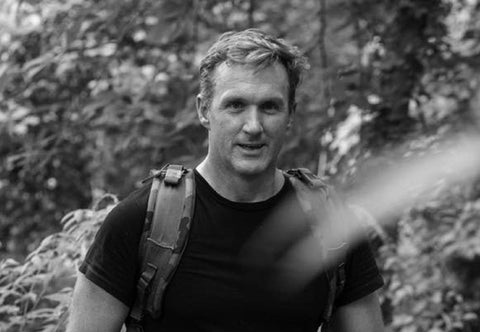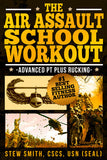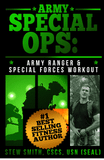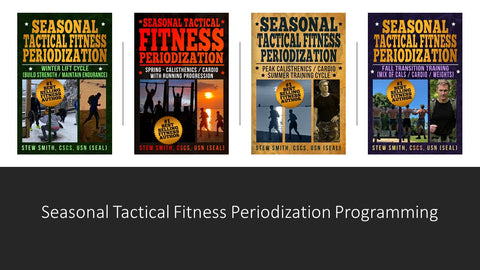Tactical Athletes and the Goldilocks Zone:
Diversify Your Training and Find a Foolproof Method To Building A Durable Tactical Athlete with Work Capacity With Healthy Longevity
Everyone knows the fairy tale of Goldilocks and the Three Bears and you may have heard of the “Goldilocks Zone” as it refers to astronomy looking for the perfect distance a planet from a star needs to be for life to exist. Well, we can also apply that zone of abilities to tactical fitness training and the athletes in the tactical professions (military, / special ops, police, fire fighter / EMT, first responders). The tactical athlete requires a perfect balance ("just right") of all the elements of fitness to be effective in the most physical missions that may occur. Obviously, the need for higher levels of fitness depends on the job of the member of the tactical population, but there is still a level of fitness regardless of the job that needs to be in the “Goldilocks Zone”.
Defining Tactical Fitness
I personally define Tactical Fitness as the following: The ability to perform military, police, firefighting, and other personal survival / rescue related skills such as running, rucking, swimming, buddy rescue, climbing, jumping, and equipment carry. All the elements of fitness that a tactical athlete must develop are strength, power, speed, agility, muscle coordination, balance, cardio endurance, muscle stamina, flexibility, mobility, and grip.
The Spectrum of Fitness and the Goldilocks Zone
There is obviously a very wide spectrum of physical fitness abilities in human performance, and it is still quite wide within the tactical professions as well. In fact, each element of fitness can have its own spectrum as many people in the tactical professions either undershoot their fitness goals or even overshoot their fitness goals and wind up injuring themselves and being useless at work. The comparison of different levels of fitness within each of the elements of fitness below describes many of the issues tactical athletes deal with considering how they train, eat, sleep, and think of themselves as athletes (or not).
General Health and Wellness – All tactical athletes need to have the general health and wellness standards as part of their annual medical checkups and strive to set personal records each visit. Triglycerides and blood pressure too high? See if you can fix it by eating better and exercising a little more / lose some weight before you must start taking medications. Being healthy (mentally, physically, emotionally, and medically) is the absolute minimum standard we all should strive for regardless of our profession, but for the tactical athlete, this is a must and anything other than healthy makes you a potential liability and ineffective doing your job DEPENDING on your job.

Strength: Being strong and having a foundation of strength in your athletic history or as you work to add strength as to transition into the tactical professions is critical to all your other abilities – including grip. This does not mean that you must bench press a 2x your bodyweight. With strength comes durability. Being durable to handle load bearing, equipment carries, people carry, and the pounding of repetitive impact comes from strength training. Strong muscles, bones, and connective tissues will assist in your ability to make power when you need it. This does not have to be 1 rep max strength, but 3-5 rep max lift ability should be tested often. Don't skip leg day or any days in the gym!

Power: Power is strength and speed combined as in the equation: Power = Force x Velocity. The faster you move an object or yourself through space is power. You can increase the power of your pushups and squats by pushing so hard and fast that you leave the ground (clapping pushups or jumping). Look for ways to add power to movements and understand the development of power becomes a multiple joint kinetic chain of events typically starting with pushing off the floor and driving the force through the body, across the torso and into the hands (aka a boxer’s punch).
Endurance: Cardiovascular endurance (aerobic and anaerobic) is necessary for nearly any activity, including running, rucking, and swimming, but also long workdays that require work capacity. How long you can move without exhaustion is a byproduct of training both aerobically and anaerobically. How fast and for how long you can run, ruck or swim longer distances will be the typical measure for your endurance ability. The common link between muscle stamina and endurance is your ability to make it useful in a long day (and night) of activity.

Muscle Stamina: When you think muscle stamina, you likely think of 2 minute fitness tests of calisthenics, but it is more than just that. It can be hours long events of manual labor, several minutes of obstacle courses, or climbing rough terrain. It is a combination of strength and endurance and typically places you in the anaerobic zone of energy systems. A two-minute calisthenics fitness test is one way to test your muscle stamina, but another marker is putting in a full day of hard physical work. Having the ability to continuously move your body weight and more over longer periods of time is required in the typical selection programs. Strength is handy. You need it. But being able to work all day is a physical skill and mindset that needs to be fostered daily. When preparing for special ops programs, there is “no 30-minute workout that will prepare you for a day of special ops training”. Endurance and muscle stamina require time in the saddle (running, rucking, swimming, PTing, and moving).
Speed: Testing speed with short runs can save your life when having to quickly run for cover. Speed can be enhanced by adding in faster and shorter runs to your running days. Adding flexibility and mobility will also help your legs move faster when needed and help you not get injured pulling typical soft tissues like the Achilles Tendon, hamstrings, and groin. 
Agility: Accompanied with speed and balance, agility is how quickly you can move from side to side and change direction quickly as well as stop on a dime and jump over, crawl under obstacles if needed. Both speed and agility can be practiced with cone drills arranged in less than 10 second drills, where full speed and changes of direction are measured. Being able to move fast and not get injured is the goal with tactical fitness agility. Saving your life when potential danger requires an immediate movement, jump, slide, roll, and duck is the gold standard. We are not trying to build 100m sprinters and world class pro-agility test takers, just quick movers and thinkers.
Mobility / Flexibility: Do not forget to warmup and stretch for flexibility, but also to move your joints through a full range of motion for mobility. Like many elements of fitness, if you don't use it, you lose it. So, make stretching and moving in a full range of motion part of your day. In fact, add a mobility/flexibility day in the middle of your week if you truly want to change your life and see better workouts on the latter half of the week. This will change your life: Don’t Skip Mobility Day.

Running / Rucking: Being prepared to run and ruck takes time. Time spent logically progressing your weekly mileage in running and building time under the weight with rucking must be a foundation of your training if attempting most military and any Special Ops training program. Lack of preparation will mean injury and possibly failing to meet the standard within a few months of training. If you don't practice several days a week to build your endurance, you will lose it.

Swimming / Water Confidence Skills: Not having a pool to train in or not being comfortable in the water is not only a physical fitness issue, but a huge mental block for many. Technique is critical to your success in the water. Watch videos and practice, practice, practice if you need to get better in the water for your swimming, drown-proofing, and treading tests. Several days a week of technique training is required, along with building your cardiovascular endurance to maintain any pace. It does the tactical athlete no good to ineffective on 75% of this planet.

Hand / Eye Coordination: Whether it is shooting, driving, flying, throwing, or lifting objects to be placed a certain way, having a background with hand eye coordination is helpful to any tactical athlete. Sports can be a great for building this skill but maintaining and obtaining good hand / eye coordination requires practice.

Tactical Athletes Need a “B” Grade in Everything
Athletes specialize is mastering only a few of these elements of fitness. Tactical Athletes have a responsibility to themselves and their team to diversify their athletic training and not neglect elements of fitness that may not thoroughly enjoy. World class athletes specialize in only a few of the above for their athletic events. For instance, take the competitive Olympic swimmer or power lifter who would score a high A in their respective events. Both are incredible to watch, but both would fail miserably at each other's events on an Olympic stage. The tactical athlete must be able to do both events well at a B level.

So Many Ways to Screw This Ups:
- There is no need to try an Olympic swim or running plan used by your favorite Gold Medalist to help you pass a fitness test of a 500m swim or a 1.5 mile timed run -- even if you are trying to be a Special Ops team member.
- Trying to deadlift 600+ pounds, which is a massive amount but still nowhere near world class, may cause injury or interfere with your ability to run, ruck, or swim with fins for long distances.
- Add running too much may interfere with your ability to gain strength or mass.
- This does not mean stop doing one for the other, it just means have a cycle that focuses on growth on one and maintenance on the other. See assessment tool on what is “good enough” standards in the tactical professions.
- Check out this fun article comparing Tactical Athletes to Olympians.

In the end, the goal is to be tough, durable with high work capacity. Though your athletic history may put you on the far right of the spectrum in some events, there will be equal weaknesses you have to deal with along your transition to tactical athlete. The most important part is to not neglect any element of fitness and be on the left side of the spectrum of fitness. Find the middle of the spectrum and it will be “just right” for your profession. Make your annual training plan a system that incorporates your weaknesses and maintains your strengths. Learn about Seasonal Tactical Fitness Periodization if you need an idea of how to create a systemic method to training vs. a randomized approach to something complicated and not worth neglecting any elements of fitness. Make sure your progressions into weaknesses are logical so that you do not start off with too much, too soon, too far, or too fast, and end up hurting yourself with challenging programs designed for something not related to the Tactical profession.
Check out Seasonal Tactical Fitness Programming
Training is What We Do:
Need Programming for Fitness Tests and Beyond? We are all about getting you TO and THROUGH your future training program. See how that works.
There is More To StewSmithFitness.com than a You May Know
(In fact, there are more than 40 books, 1000+ articles, online coaching - and more)

Who is Stew Smith CSCS? Coach, Trainer, Writer, Podcaster: I'm the former Navy SEAL that tactical candidates go to for books, ebooks and online coaching to prepare themselves to get to and through intense tactical assessment and selection programs and qualify for service in their chosen tactical profession. See More at StewSmithFitness.com
Where to Find More Information About Optimal Performance Training Programs
When you start training again, consider the seasonal tactical fitness model. I call it A WAY to train and obviously not the only way to train. But it offers the opportunity to never neglect your weaknesses, helps with flexibility and mobility, but will also put you at a level of physical abilities where you are happy with your overall ability to do just about anything. We have a system where the seasons dictate our training. When it is nicer outside, we tend to run and do more calisthenics. When it is colder and not so nice, we lift more, run less, and still maintain our outdoor activities with shorter runs and rucks. Check it out: Seasonal Tactical Fitness Periodization System.
Where Optimal Performance Will Be Tested Each Day
The Specific Military / Special Ops Physical Fitness Workouts
Navy SEAL Workout Phase 1
Navy SEAL Workout Phase 2 - 3
Navy SEAL Workout Phase 4 Grinder PT
Navy SWCC Workout
Army / Air Force Advanced Fitness / Special Ops
Army PFT Workout (Prep For Rucking, OPAT, ACFT)
Army Special Forces / Ranger Workout
Army Air Assault School Workout
Army Airborne Workout
Air Force Special Warfare IFT / OFT / Selection Prep






Advanced Running Program - Special Ops Supplement Plan
USMC RECON / MarSOC Workout
USMC OCS / TBS Workout
USMC IST and PFT
The Combat Conditioning Workout
Air Force PJ / CCT Workout Battlefield Airman Prep Course
The UBRR Upper Body Round Robin Workout / Spec Ops version
The Coast Guard Rescue Swimmer / Navy SAR Workout
The Service Academy Workout (West Point, Navy, Air Force Academy)
The Navy, Air Force, Marine Corp Boot Camp Workout
The Law Enforcement Physical Fitness Workouts
The FBI Academy Workout | FBI Workout Vol 2
The DEA Workout
The FLETC Workout - Ace the PEB
The PFT Bible: Pushups, Sit-ups, 1.5 Mile Run
The Fire Fighter Workout - Ace the CPAT
Online Coaching Options
Online PT CLUB - Weekly Workouts created personally for you.
New Member's Only Content / Services Program!
If you want access to years worth of workouts, many of the top eBOOKs, favorite workouts of the week, free fitness APP, closed Facebook Group, video / picture library of exercises, and more access to LIVE Q/A sessions check out the Stew Smith Fitness Members Section.
The dashboard below has the links to all the information, archives, videos, and links to workouts, podcasts, live Q and A lessons.
Consider this! - A Membership Program and Gain Access to Exclusive Content
(click for Fitness Club Dashboard - members only)
Questions? Just email - Stew@StewSmith.com
At StewSmith.com - List of Products and Services
- FREE Articles
- Podcasts and Swimming Videos (Youtube, TikTok, Instagram)
- eBooks
- Books and eBooks in PRINT
- Stew Smith Fitness Club membership site
- Online Coaching
Stew Smith Fitness



















